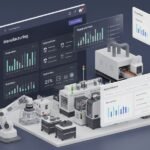Have you ever felt burdened by the never-ending flood of emails in your inbox? That’s what businesses deal with today. But instead of emails, it’s data they deal with. We currently live in the age of information overload. Data has become the lifeblood of any successful business. But with so much of it flying around, how do we make sense of it all? How do we turn it into something useful? This is where the magic of data engineering comes in.
Data engineers essentially create models that collect, clean, and organize big data. Their main goal is to make data analysis simple and easy, which is what makes them the most important members of the data world.
The world of data engineering today is constantly on the move. So, buckle up and get ready for a sneak peek into the future.
In this blog post, we’ll explore five key Data Engineering Predictions that will likely transform how we manage and leverage data in the coming year.
Prediction 1: The Rise of Cloud-Native Data Engineering
Traditionally, data engineers built and maintained their systems to handle all the data coming in. But the cloud offers a whole new way of working. Based on our Data Engineering Predictions, here’s the gist:
Cloud storage
Instead of buying and managing your own servers, the cloud allows you to rent space in a giant online data center. This includes centers such as Amazon Web Services, Azure, Google Cloud, etc.
Cloud processing
Need to crunch a ton of numbers on your data? No problem. The cloud lets you rent powerful computers for short periods to tackle big jobs. You only pay for what you use. This allows you to hire a team of super-powered analysts by the hour.
Cloud analysis
The cloud also offers tools to analyze your data directly. This means that you don’t need to move around data as much.
This “cloud-native” approach to data engineering is becoming increasingly popular because it offers several big advantages, including scalability, agility, cost-effectiveness, etc.
Prediction 2: Real-Time Data Streaming Takes Center Stage
Today, information moves faster than ever before. Accessing and understanding data in real-time is becoming very important. This is where real-time data streaming comes into the picture.
Now, you can access a constant flow of data, like a live feed. Instead of waiting for information to be collected and stored in batches, you can acquire it easily. This is the essence of real-time data streaming. It allows businesses to capture and process data as it’s generated. This enables them to react and make decisions quickly.
Based on Data Engineering predictions, here’s why real-time data streaming is the future:
Faster Insights
No more waiting for reports or historical data analysis. Streaming lets you analyze data as it arrives, enabling you to uncover trends and patterns immediately and stay ahead of your competitors.
Improved Decision-Making
This approach leads to positive outcomes for businesses. Now, with real-time insights, businesses have the latest information. This leads to making informed decisions.
Enhanced Customer Experience
Real-time data can personalize customer interactions. You can now identify and address issues as quickly as they arise, providing a more responsive experience to your users.
There are powerful frameworks available that can crunch up data in real time. Two popular examples are:
- Apache Kafka: This is an open-source platform. It is a center for soaking up and distributing real-time data streams.
- Apache Flink: This processing engine allows you to analyze real-time data streams.
Prediction 3: AI and Machine Learning Reshape the Data Engineering Landscape
As mentioned before, the data engineering industry is undergoing a massive change. This industry is getting a major upgrade with the help of super-smart tools. These tools are none other than Artificial Intelligence and Machine Learning (AI and ML).
Data Engineering predictions suggest that AI/ML is reshaping the world of data engineering in the following ways:
Automated Tasks
Data engineers often need to perform certain functions. These include cleansing, schema validation, data lineage, etc. MIL algorithms can trace and automate this data. This frees up data engineers to focus on more strategic work.
Improved Data Quality
AI can detect errors in data streams. This will make sure that your data analysis is accurate and reliable.
Optimized Data Pipelines
ML algorithms can analyze data flow and suggest optimizations for your data pipelines. This will improve efficiency and performance.
Looking ahead, there’s an exciting development called Large Language Models (LLMs). LLMs are advanced AI models trained on massive amounts of text data. This has the potential to further change the world of data engineering.
Prediction 4: Data Democratization and Collaboration
Earlier, people used to find the whole idea of data complex. It used to be this secret language that only a few people in a company could understand. But now, there’s a new trend called “data democratization.’’ This is like translating that secret language into a language that everyone in the company can understand and use. No more secrets; everyone gets to be in on it. This allows all employees to make smarter decisions, no matter their department. It’s beneficial for everyone involved.
Your data is like a hidden pipeline. You can see how the data flows, find any problems, and make sure your information is accurate. Data Engineering predictions suggest that this is important for a few reasons:
- Catch data mistakes early: You can fix them before they mess up your analysis.
- Keep things running smoothly: You can find slowdowns in your data flow and fix them.
- Spot suspicious activity: Data observability helps you catch security risks.
This does mean some changes are needed. Data engineers will need to work more closely with other teams. Collaboration will be key. Data Engineering predictions point out the following:
- Talk it out: Data engineers need to explain complex data in a way everyone understands.
- Easy-to-use tools: It is important to build tools for non-tech people to understand data themselves.
- New skills: Data engineers need to learn to teach others about data.
- Teamwork makes the dream work: Data engineers, analysts, and business people might need to collaborate even more closely.
Prediction 5: Focus on Data Observability and Governance
Your data is vital. However, it needs to be clean, reliable, and safe. That’s where data observability comes in. It’s a super helpful window into your data. You can see how the data moves. Hence, you can find any issues within it. This makes sure that your data is always accurate. Here’s what Data Engineering predictions say about this:
- It catches data mistakes early. Hence, you won’t mess up your analysis later.
- It keeps your data models running smoothly. Finding slowdowns makes this possible.
- It helps you spot suspicious activity that could put your data at risk.
Your data needs two things: good monitoring and clear rules. Data governance ensures your data is safe, appropriately used, and only accessed by authorized people. It’s like having a system for handling valuable company property.
The Future of Data Engineering: A World of Opportunity
Our data engineering predictions clearly show that the future of data engineering is full of exciting opportunities. From real-time data analysis to the development of AI/ML, data engineers will change how they operate. They are now likely to have many new methods and techniques at their disposal.
As we move forward, data engineers will play a pivotal role in shaping organizations’ futures. By accepting and developing these trends, they can push businesses to make smarter decisions.












